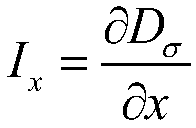An infrared weak small target detection method based on tensor robust principal component analysis
A technology of principal component analysis and weak and small targets, which is applied in the field of infrared weak and small targets based on tensor robust principal component analysis, can solve the local optimal solution of nuclear norm and local structure weight, detect target distortion, and target detection accuracy low level problem
- Summary
- Abstract
- Description
- Claims
- Application Information
AI Technical Summary
Problems solved by technology
Method used
Image
Examples
Embodiment 1
[0169] Such as Figure 1-16 As shown, a method for detecting small infrared targets based on tensor robust principal component analysis includes the following steps:
[0170] Step 1: Use the sliding window to traverse the original image to construct a third-order tensor;
[0171] Step 2: Calculate the second-order structure tensor of the original image, and construct the structure weight tensor according to the second-order structure tensor;
[0172] Step 3: Use the tensor robust principal component analysis to construct the objective function, input the third-order tensor and the structural weight tensor into the objective function, and use the alternating direction multiplier method to solve the objective function to obtain the background tensor and the target tensor;
[0173] Step 4: Reconstruct the background image and target image according to the background tensor and target tensor;
[0174] Step 5: Carry out adaptive threshold segmentation on the target i...
Embodiment 2
[0177] Based on embodiment 1, step 1 includes the following steps:
[0178] Step 1.1: Acquire the infrared image D∈R to be processed m×n , with a size of 240×320;
[0179] Step 1.2: Use a sliding window w with a size of 50×50 to traverse the original image D with a step size of 50, and use the matrix with a size of 50×50 in each sliding window w as a frontal slice;
[0180] Step 1.3: Repeat step 1.2 according to the number of window slides until the traversal is complete, and form all frontal slices into a new tensor
[0181] Such as figure 2 As shown in , it represents an infrared image with a complex background, in addition to weak and small targets, there are also high-brightness white false alarm sources; for example image 3 As shown, it represents the third-order tensor constructed from the original image after step 1
[0182] Step 2.1: Compute the structure tensor J of D ρ ∈ R 480×640 :
[0183]
[0184] Among them, K 2 Indicates...
Embodiment 3
[0196] Based on embodiment 1 or 2, step 3 includes the following steps:
[0197] Step 3.1: Input the third-rank tensor and structure weight tensor Combining tensor kernel norm and tensor l 1 Norm, build the objective function;
[0198] Step 3.2: and After inputting the objective function, use the alternate direction multiplier method to solve the objective function and solve the background tensor and the target tensor
[0199] Step 3.1 includes the following steps:
[0200] Step 3.1.1: Assume a third rank tensor from low-rank tensors and sparse tensors composed of separate and ε, construct the objective function as follows:
[0201]
[0202]
[0203] Among them, λ represents the balance coefficient, ||g|| * Indicates tensor kernel norm, ||g|| 1 represents the tensor l 1 norm,
[0204] Step 3.1.2: Order express The result of doing discrete Fourier transform (Discrete FourierTransform, DFT) along the third d...
PUM
 Login to View More
Login to View More Abstract
Description
Claims
Application Information
 Login to View More
Login to View More - R&D
- Intellectual Property
- Life Sciences
- Materials
- Tech Scout
- Unparalleled Data Quality
- Higher Quality Content
- 60% Fewer Hallucinations
Browse by: Latest US Patents, China's latest patents, Technical Efficacy Thesaurus, Application Domain, Technology Topic, Popular Technical Reports.
© 2025 PatSnap. All rights reserved.Legal|Privacy policy|Modern Slavery Act Transparency Statement|Sitemap|About US| Contact US: help@patsnap.com



